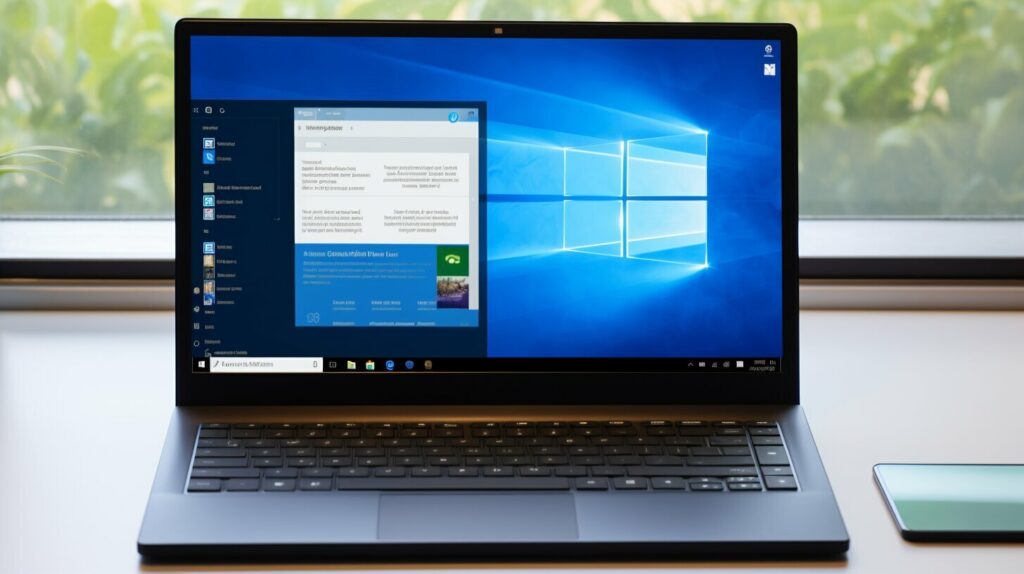In today’s digital age, file integrity verification has become increasingly important to ensure secure file authentication. Checking file signatures is a crucial step in this process and can help prevent malware attacks and unauthorized file modifications. In this section, we will explore the steps involved in verifying a file’s digital signature and the importance of digital certificates in the authentication process.
Key Takeaways:
- Verifying a file’s digital signature is crucial for ensuring file integrity and preventing malware attacks.
- Digital certificates play a significant role in the authentication process.
- File signature verification is necessary for maintaining system security in both Windows and Mac OS.
Understanding Digital Signatures
In today’s digital age, file integrity verification is crucial for ensuring secure file authentication. Digital signatures play a significant role in this process by verifying the authenticity and integrity of files. A digital signature is essentially a mathematical code that is attached to a file to verify its authenticity. This code is generated using a private key that is linked to a digital certificate.
Digital certificates are issued by trusted third-party authorities and contain information about the entity that issued the certificate, the entity to which it was issued, and the public key associated with the private key used to generate the digital signature. When a file is digitally signed, the digital certificate is also attached to the file.
The role of digital certificates in the process of verifying file signatures is significant. They act as a seal of approval that confirms the identity of the entity that signed the file and ensures that the file has not been tampered with since it was signed. Performing a code integrity check is essential for software code security, and digital certificates play a crucial role in this process.

Image description: An image showing a digital signature on a document.
How to Check a File’s Digital Signature
Verifying a file’s digital signature is crucial for ensuring that the file is authentic and has not been tampered with. There are various methods and tools available for verifying file signatures, including the use of code signing certificates. To check a file’s digital signature, follow the steps below:
- Open the file properties: Right-click on the file and select “Properties.”
- Select the digital signature tab: In the file properties dialog box, click on the “Digital Signatures” tab.
- View signature details: Select the signature from the list, and click on the “Details” button to view its details.
- Verify the signature: In the signature details dialog box, click on the “View Certificate” button to view the certificate details. Check the certificate’s validity and ensure that it has not expired or been tampered with.
Alternatively, you can use code signing certificates to sign your files and ensure their authenticity. A code signing certificate is used to verify the identity of the software publisher and ensure that the code has not been tampered with or modified since it was signed. With a code signing certificate, you can sign your files and allow your users to verify the digital signature to ensure the authenticity and integrity of the file.
Verifying File Signature in Windows OS
It is crucial to check file signatures in the Windows operating system for system security and file integrity. Verifying a file’s digital signature in Windows is a straightforward process using built-in Windows tools.
Here are the steps to check a file’s digital signature in Windows:
- Right-click on the file you want to verify.
- Select “Properties” from the drop-down menu.
- Click on the “Digital Signatures” tab.
- Select the signature from the list and click on the “Details” button.
- Click on the “View Certificate” button to view the certificate information.
- Check if the issuing authority and certificate details are correct and if the signature is valid.
If the file has a valid digital signature, it means the file has not been tampered with and that the certificate authority has verified its authenticity and integrity. If the file signature is invalid or missing, it may indicate that the file has been modified or is not from a trusted source.

Verifying file signatures in Windows OS is essential for maintaining file security and system integrity. It also helps to identify potential malware or unauthorized modifications to files. It is crucial to ensure that you check the digital signature of every file you download or install, especially from unknown sources or suspicious websites.
Validating File Signature in Mac OS
Checking the authenticity of a file’s digital signature in Mac OS is a straightforward process that can be performed using built-in tools. It is a crucial step in ensuring file integrity and protecting against malicious software.
The first step is to right-click on the file and select “Open”. A pop-up window will appear, indicating whether the file is from a verified source.
If the file is not from a verified source or the signature is invalid, an alert message will appear, warning the user not to open the file. However, if the file is from a verified source, it can be opened without any further action.
For additional information, users can check the digital certificate associated with the file by selecting “Get Info” after right-clicking on the file. This will display the certificate details, including the certificate authority and expiration date.
It is worth noting that some Mac OS versions may require users to adjust their security settings to verify digital signatures. Users can change these settings by navigating to “System Preferences” and selecting the “Security & Privacy” tab.

By verifying file signatures in Mac OS, users can ensure the authenticity and integrity of their files and protect against potential security threats. It is a simple yet crucial step in maintaining file security.
Online Tools for File Signature Validation
Online tools provide an easy and convenient way to check the digital signature of a file. These tools are particularly useful when you don’t have access to built-in verification tools or when you need to verify signatures of files that are not on your local machine.
One popular tool for file signature validation is VirusTotal. It is a free online service that allows users to upload files and check them against multiple antivirus engines. VirusTotal also checks the digital signature of the files to ensure their authenticity.
Another useful tool is Jotti’s malware scan. It checks files against multiple antivirus engines and also verifies their digital signature. Jotti’s malware scan is a free, web-based service that does not require any registration.
Microsoft’s online file checker is another option that can be used to verify the digital signature of files. It is a free tool that can be used to check individual files or entire directories. The tool checks the digital signature of files and also warns users if any of the files are not signed or signed with an invalid certificate.
Using online tools for file signature validation can help you ensure the authenticity and integrity of files, even when you don’t have access to built-in verification tools. These tools are particularly useful when checking files downloaded from the internet or when working with files that have been shared by others.
Importance of Digital Signatures in Software Development
Software development is a complex and highly intricate process that involves multiple stakeholders, including developers, designers, and testers. One of the critical concerns in software development is security, and digital signatures play a crucial role in ensuring software code security.
Digital signatures provide a unique identifier for software code, verifying its authenticity and integrity. They enable developers to track changes, detect unauthorized modifications, and ensure the code remains secure from malware and other types of cyber attacks.
Code integrity checks and code signing certificates add an extra layer of security to software development. They help ensure that only legitimate code is executed on a user’s computer or device, preventing malicious code from running.
Digital signatures also contribute to building trust and credibility among users. Digital certificates act as a seal of authenticity, reassuring users that the software code they are downloading or using comes from a legitimate source and is safe to use.
As software applications become more complex and interconnected, the need for digital signatures and other security measures becomes even more critical. The consequences of not implementing digital signatures can be devastating, resulting in data breaches, system crashes, and other security incidents.

Today, many software development frameworks and platforms provide tools for code signing and digital signature verification. Developers can easily integrate these tools into their workflow, ensuring that every piece of code they create is properly authenticated and secure.
Overall, digital signatures play a critical role in ensuring software code security, protecting against malware, and building user trust. Developers must prioritize digital signature implementation and maintain code integrity to ensure safe and secure software code for users worldwide.
Benefits of Having a Secure File Signature
Ensuring secure file authentication and file integrity verification are critical in protecting against unauthorized file access and tampering. Having a secure file signature provides numerous benefits, including:
- Enhanced file authenticity: A valid digital signature on a file indicates that it has not been tampered with or modified since the signature was added. This provides assurance to end-users that the file they are downloading or using is legitimate and hasn’t been altered from its original form.
- Protection against file tampering: A file with an invalid or missing digital signature raises red flags and warns users that the file might have been modified without proper authorization, potentially containing harmful malware or viruses.
- Improved software code security: For software developers, digital signatures add an additional layer of code integrity check that verifies the authenticity of the code before it’s distributed to users. This ensures that the software code has not been altered or tampered with and prevents unauthorized modifications to the code.
Overall, having a secure file signature plays a significant role in ensuring file integrity and preventing unauthorized access and file tampering. It is crucial for individuals and organizations to prioritize file signature verification for enhanced security.
Conclusion
Ensuring the authenticity and integrity of files is crucial for maintaining system security and protecting against various threats. Digital signatures and digital certificates play a vital role in validating file signatures and verifying file authenticity. It is essential to perform code integrity checks and file signature verification regularly to protect against malware and unauthorized modifications.
Various tools and services are available for validating file signatures, including online tools that make the process quick and easy. By prioritizing file signature verification, individuals and organizations can enhance file security, minimize security risks, and protect against unauthorized access. Digital certificate validation and file integrity verification are essential for ensuring secure file authentication, and implementing these practices is an essential step towards a more secure computing environment.
FAQ
Q: How do I check if a file has a digital signature?
A: Checking a file’s digital signature involves verifying its code signing certificate to ensure its authenticity and integrity. There are several methods and tools available for this purpose, including built-in Windows tools, online signature validation services, and manual validation using cryptographic APIs.
Q: What is the importance of digital signatures?
A: Digital signatures play a crucial role in verifying the authenticity and integrity of files. They provide a secure means of file authentication, ensuring that the file has not been tampered with or modified since it was signed. Digital signatures also contribute to software code security, protecting against malware and unauthorized modifications.
Q: How can I check a file’s digital signature?
A: To check a file’s digital signature, you can follow these steps:
1. Right-click on the file and select “Properties.”
2. Go to the “Digital Signatures” tab.
3. Select the signature and click on “Details.”
4. Verify the signer’s name and certificate information.
5. Check the digital signature status to ensure it is valid and trusted.
Alternatively, you can use online tools or cryptographic APIs to validate the file’s signature.
Q: How do I verify a file signature in Windows OS?
A: Verifying a file signature in Windows OS is a straightforward process. You can use built-in tools like the File Explorer or PowerShell to check a file’s digital signature. Simply right-click on the file, go to “Properties,” select the “Digital Signatures” tab, and view the details to ensure the signature is valid and trusted.
Q: How can I validate a file signature in Mac OS?
A: Validating a file signature in Mac OS involves a few simple steps:
1. Right-click on the file and select “Open With” -> “Archive Utility.”
2. Navigate to the extracted files and locate the “CodeResources” file.
3. Open the “CodeResources” file with a text editor.
4. Look for the file’s hash value under the “Authority” section.
5. Verify the hash value against the signature’s hash.
Q: Are there any online tools available for file signature validation?
A: Yes, there are several online tools and services that can be used to validate file signatures. These tools typically allow you to upload a file and perform a comprehensive analysis to verify the file’s integrity and authenticity. Some popular online signature validation services include Virustotal and Jotti.
Q: Why are digital signatures important in software development?
A: Digital signatures play a critical role in software development by ensuring code integrity and security. They help protect against malware and unauthorized modifications by verifying the authenticity and integrity of software code. Code integrity checks and code signing certificates are essential for maintaining software code security and building trust among users.
Q: What are the benefits of having a secure file signature?
A: Having a secure file signature offers several advantages, including enhanced file authenticity and protection against file tampering. A secure file signature provides assurance that the file has not been modified or tampered with since it was signed, ensuring its integrity. It also helps in establishing trust among users and preventing unauthorized access or manipulation of files.





